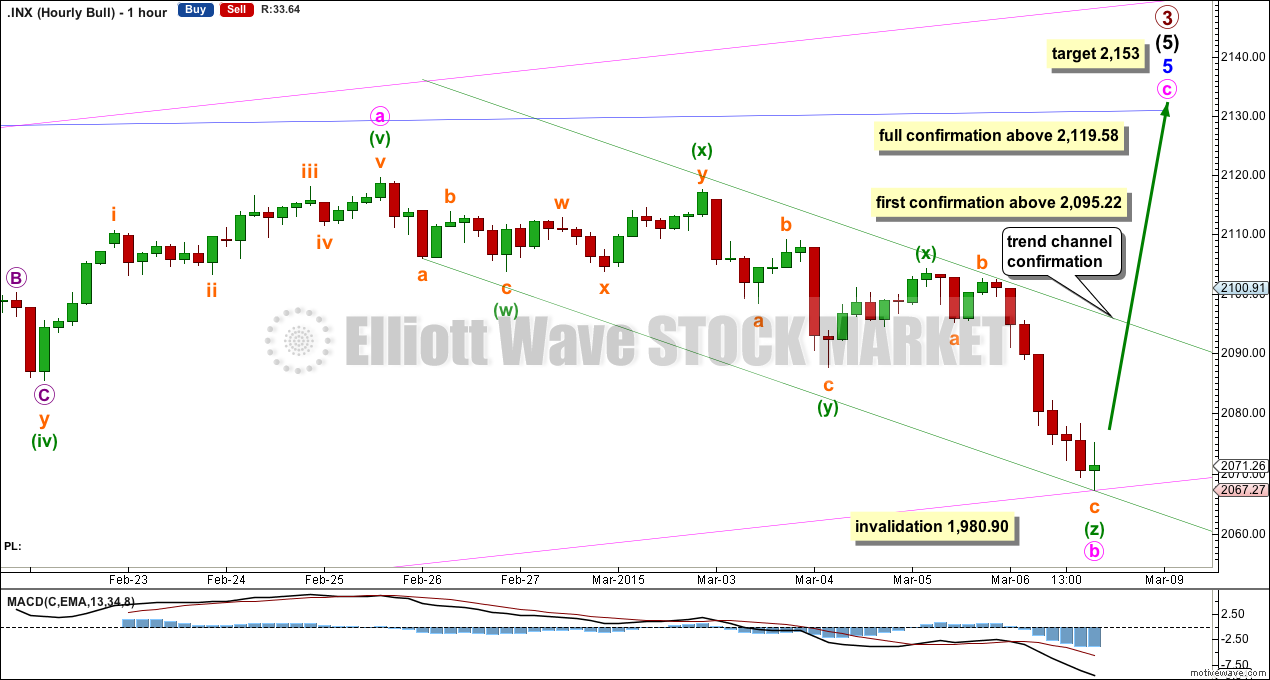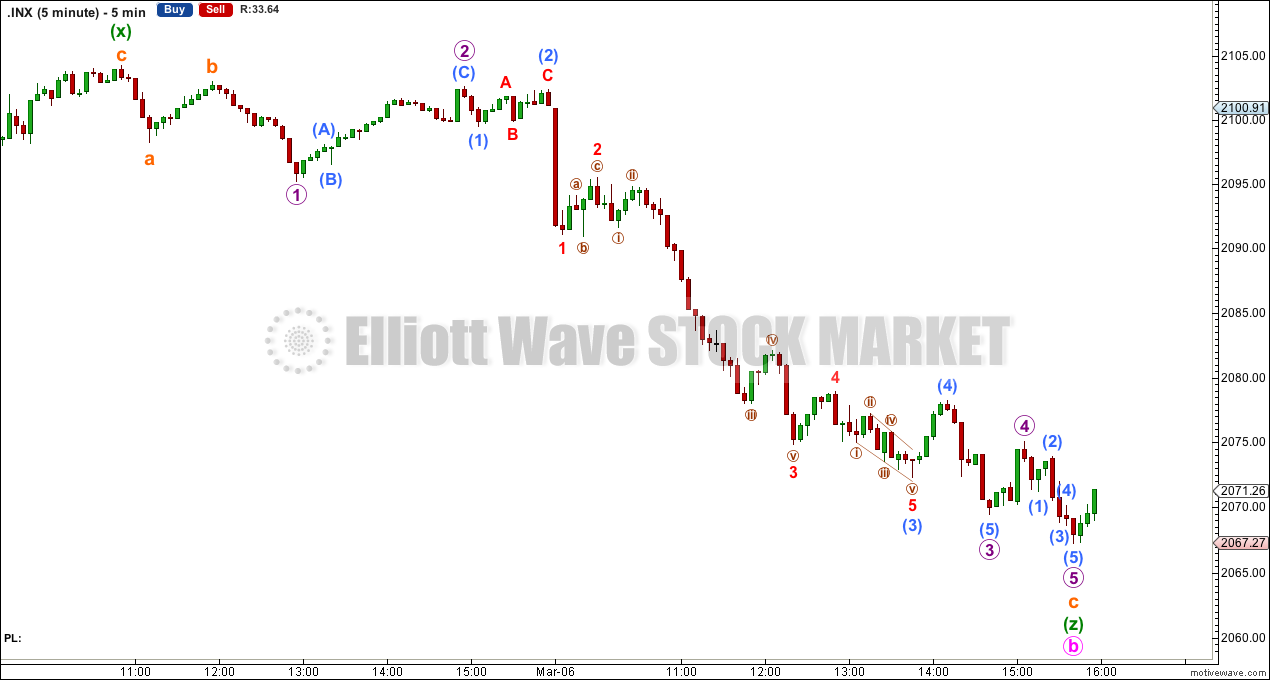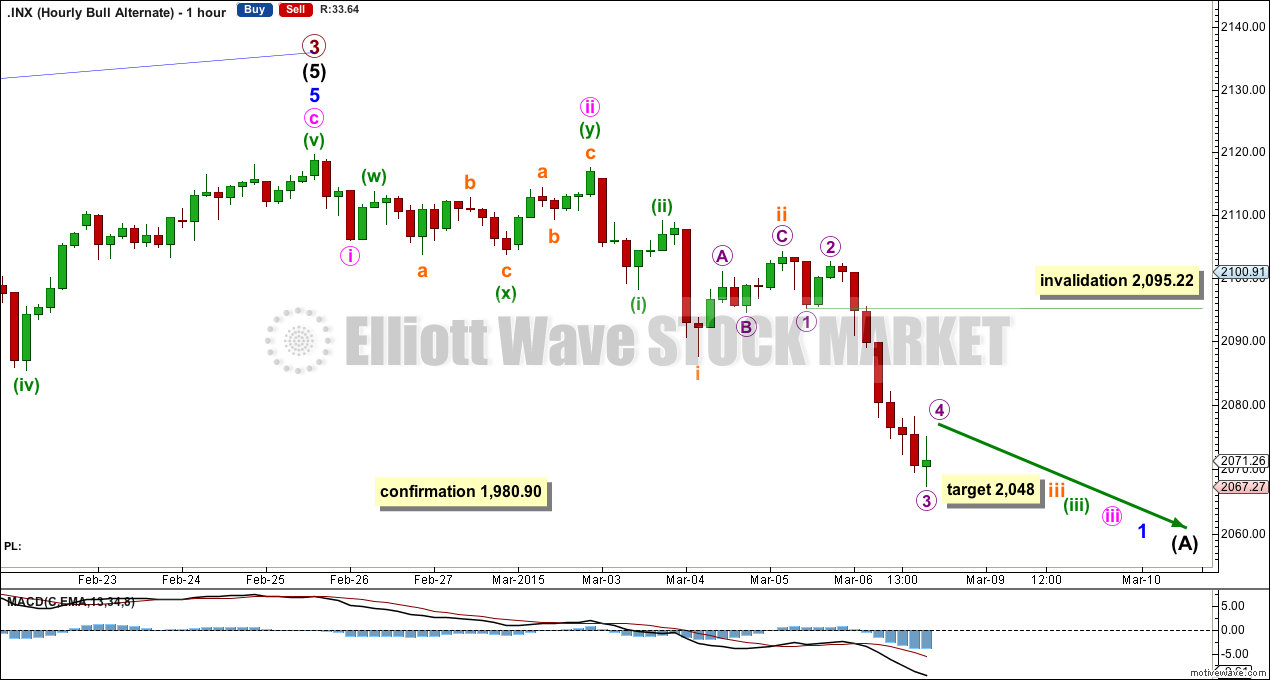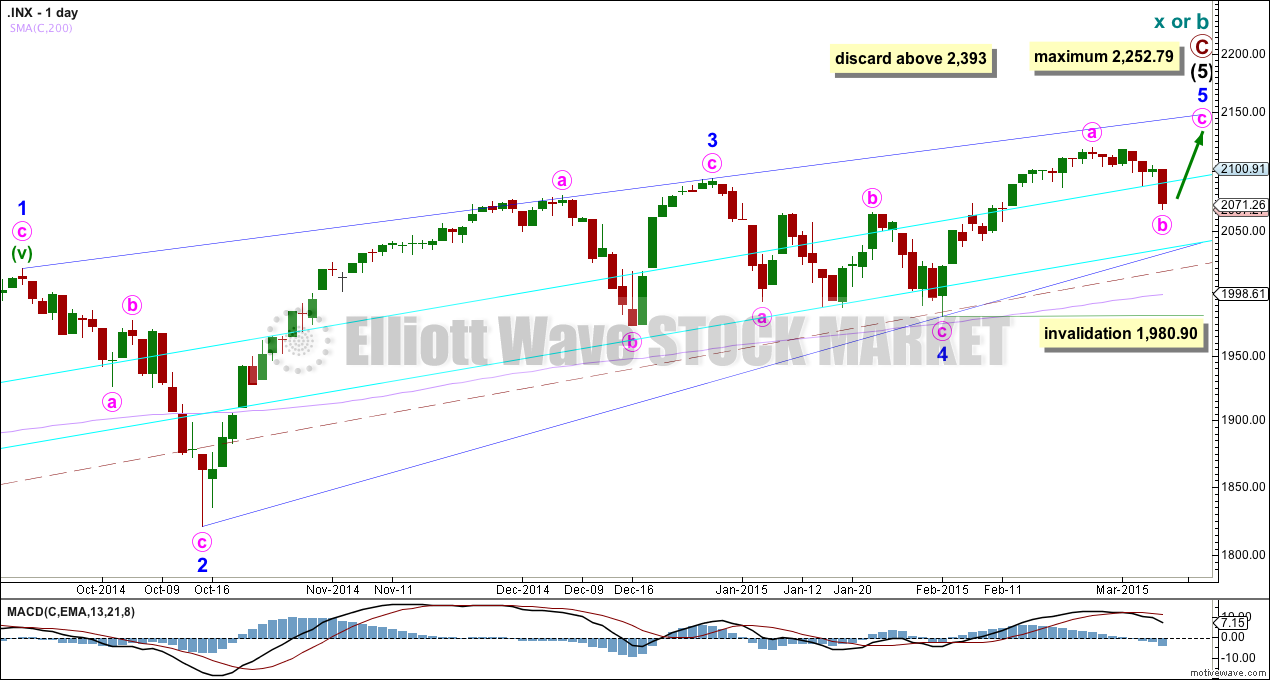Downwards movement was not expected. The hourly Elliott wave count was invalidated.
Summary: I have a new alternate wave count for you. The main wave count expects another twelve days of upwards movement to a target at 2,153. First confirmation would come with a new high above 2,095.22, and a breach of the green channel on the hourly chart. Final confirmation would come with a new high above 2,119.58. Alternatively, if price continues lower, a trend change which may be at primary or cycle degree would have first indication with a new low below 1,980.90. A close of 3% or more of market value (64 points) below the lower aqua blue trend line on the daily chart would provide confidence in a trend change at primary or cycle degree.
Click charts to enlarge.
Bullish Wave Count
Upwards movement from the low at 666.79 subdivides as an incomplete 5-3-5. For the bull wave count this is seen as primary waves 1-2-3.
The aqua blue trend lines are traditional technical analysis trend lines. These lines are long held (the lower one has its first anchor in November, 2011), repeatedly tested, and shallow enough to be highly technically significant. When the lower of these double trend lines is breached by a close of 3% or more of market value that should indicate a trend change. It does not indicate what degree the trend change should be though. It looks like the last five corrections may have ended about the lower aqua blue trend line, which gives the wave count a typical look. To see a weekly chart where I have drawn these trend lines go here.
The wave count looks at intermediate wave (5) as an ending contracting diagonal. Ending diagonals require all sub waves to be zigzags. So far this is a perfect fit. Minor wave 3 has stronger momentum than minor wave 5 on the daily chart.
The diagonal is contracting. The only problem with this possibility is that minor waves 2 and 4 are more shallow than second and fourth waves within diagonals normally are. In this case they may have been forced to be more shallow by support offered from the double aqua blue trend lines.
Because the third wave within the contracting diagonal is shorter than the first wave and a third wave may never be the shortest wave, this limits the final fifth wave to no longer than equality with the third wave at 2,253.79.
Within intermediate wave (5) minor wave 1 lasted 238 days (5 days longer than a Fibonacci 233), minor wave 2 lasted 18 days (2 short of a Fibonacci 21), minor wave 3 lasted 51 days (4 short of a Fibonacci 55) and minor wave 4 lasted 23 days (2 longer than a Fibonacci 21). While none of these durations are perfect Fibonacci numbers, they are all reasonably close. So far minor wave 5 has lasted 22 days and the structure looks incomplete. It may now end close to a total Fibonacci 34 sessions, so may continue for a further 12 sessions give or take one to two days either side of this expectation.
Within minor wave 5 minute wave b may not move beyond the start of minute wave a below 1,980.90.
Contracting diagonals normally have fifth waves which end with a slight overshoot of the 1-3 trend line. Because this is such a common tendency I will still expect more upwards movement to see this trend line overshot. It is possible that the fifth wave is over already, and I am now using this idea as an alternate.
Minute wave b may be finding support at the upper aqua blue trend line.
At this stage the only possible structure I can see for minute wave b is a rare triple zigzag, but the subdivisions are all a perfect fit. Minute wave b is now a 0.38 correction of minute wave a. Minor wave 5 now looks like it may be developing as a clear obvious three wave structure at the daily chart level. This would give the ending diagonal a very typical look.
At 2,153 minute wave c would reach 0.618 the length of minute wave a. If minute wave b continues lower this target must move correspondingly lower.
On the five minute chart minute wave b subdivides nicely as a completed corrective structure, and subminuette wave c of the third zigzag is a perfect five wave impulse. Howerver, there is not enough upwards movement at the end of Friday’s session to rule out subminuette wave c moving lower.
In the first instance I would want to see a clear breach of the green best fit channel drawn about the downwards wave of minute wave b before I have any confidence that it is over. Thereafter, a new high above 2,095.22 would provide further confidence in this main wave count. A new high above 2,119.58 would provide full and final confidence in this wave count and the target.
Minute wave b may not move beyond the start of minute wave a below 1,980.90.
Alternate Bullish Wave Count
This wave count is identical to the main wave count up to the low labelled minor wave 4. Thereafter, this alternate looks at the possibility that minor wave 5 may be over. Minor wave 5 would have fallen slightly short of the 1-3 trend line. This is unusual but does occasionally happen for fifth waves of contracting diagonals.
A new low below 1,980.90 would invalidate the main wave count. A close below the lower aqua blue trend line of 3% or more of market value would provide added confidence in this wave count. At that stage I would expect that downwards movement may be the early stages of primary wave 4. The bearish wave count below would also be entirely possible, but would require further confirmation.
Primary wave 2 was a 0.41 zigzag correction lasting 62 days in total. I would expect primary wave 4 to be more shallow because it may find support at the lower edge of an Elliott channel (which must be drawn on a weekly chart at this stage). Primary wave 4 should break out of the black channel copied over here from the weekly chart (this is a channel containing primary wave 3). A breach of that channel would provide further confidence that primary wave 3 is over and primary wave 4 is underway.
Primary wave 4 may last about a Fibonacci 55 days if it is a flat correction. If it is a combination or triangle it may be more time consuming, maybe up to a Fibonacci 89 days.
We should always assume the trend remains the same, until proven otherwise. At this early stage we have no confirmation of a big trend change, so this idea must remain an alternate until we do. We should assume the trend remains up.
If there has been a trend change at primary or cycle degree, then a clear five down should develop at the hourly and daily chart levels. So far this would be incomplete, and should have begun with a series of overlapping first and second waves. At 2,048 subminuette wave iii would reach 2.618 the length of subminuette wave i.
Within subminuette wave iii micro wave 4 may not move into micro wave 1 price territory above 2,095.22.
Bear Wave Count
The subdivisions within primary waves A-B-C are seen in absolutely exactly the same way as primary waves 1-2-3 for the bull wave count. The alternate bull wave count idea also works perfectly for this bear wave count.
To see the difference at the monthly chart level between the bull and bear ideas look at the last historical analysis here.
At cycle degree wave b is over the maximum common length of 138% the length of cycle wave a, at 167% the length of cycle wave a. At 2,393 cycle wave b would be twice the length of cycle wave a and at that point this bear wave count should be discarded.
While we have no confirmation of this wave count we should assume the trend remains the same, upwards. This wave count requires confirmation before I have confidence in it.
This analysis is published about 05:36 a.m. EST.






